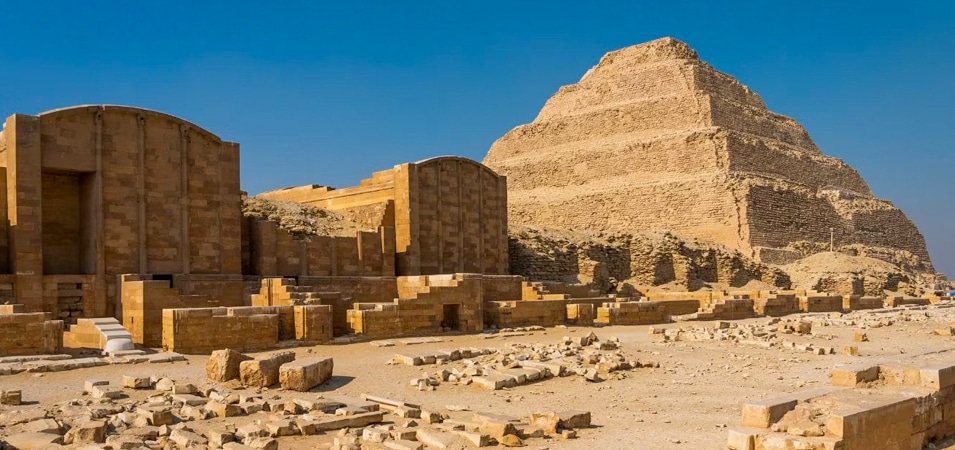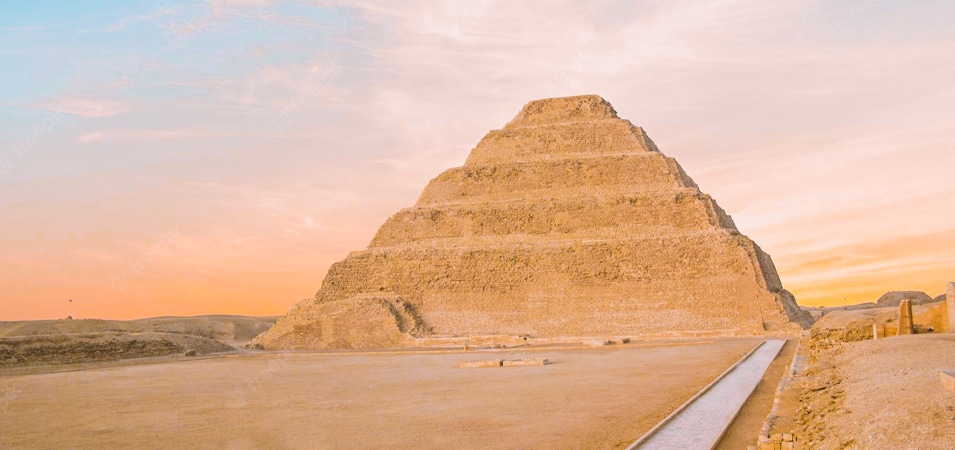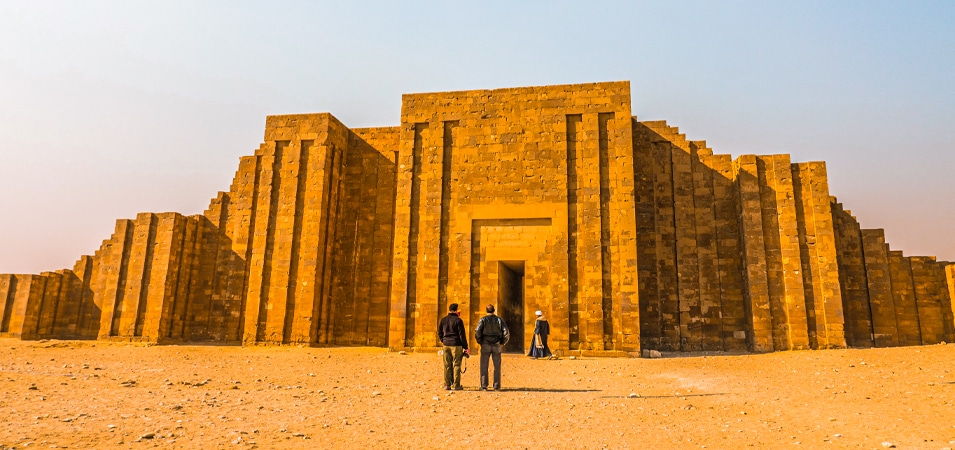Deep in the Saqqara necropolis near Cairo, the Djoser Step Pyramid is an extraordinary testament to ancient Egypt’s architectural ingenuity and cultural significance. Built during the 27th century BCE, this iconic structure represents a pivotal moment in the evolution of pyramid construction. Join us as we embark on a journey to explore the history, design, religious significance, and enduring allure of the Djoser Step Pyramid.
A Marvel of Ancient Egyptian Architecture
In the vast desert expanse of Saqqara, near Cairo, the Djoser Step Pyramid is a testament to ancient Egypt’s architectural genius and cultural significance. Built over 4,600 years ago during the reign of Pharaoh Djoser, this awe-inspiring structure represents a pivotal moment in the evolution of pyramid construction. Join us as we embark on a journey to explore the history, design, religious significance, and enduring allure of the Djoser Step Pyramid.
Don’t Miss To Check Out OurEgypt Travel Packages
The Rise of the Step Pyramid: A Revolution in Pyramid Construction

The Reign of Pharaoh Djoser: An Era of Innovation: During the 27th century BCE, Pharaoh Djoser sought to create a monumental structure that would serve as his final resting place and showcase his power and divine connection. His visionary reign marked a period of innovation and experimentation in Egyptian architecture.
Architect Imhotep: Mastermind Behind the Pyramid: Imhotep, a renowned architect and high-ranking priest, was entrusted with designing and constructing the Djoser Step Pyramid. His genius and forward-thinking approach would revolutionize pyramid architecture for centuries to come.
Departure from Mastaba Tombs: The Birth of the Step Pyramid: The Djoser Pyramid departed from traditional mastaba tombs, introducing a new form of pyramid construction. Imhotep ingeniously stacked six mastabas on top of each other, creating a step-like structure that would become the precursor to the iconic pyramids of Giza.
Architecture and Design: A Marvel of Engineering
Structure and Layout: The Step Pyramid Complex: The Djoser Pyramid complex comprises various elements, including the pyramid, courtyards, ceremonial structures, and a vast enclosure wall. The complex was meticulously designed to reflect the pharaoh’s divine status and facilitate religious rituals.
Construction Techniques and Materials: Imhotep employed advanced construction techniques for the time, using locally sourced limestone blocks and organizing them step-likely. The precise craftsmanship and engineering ingenuity allowed the pyramid to endure for millennia.
The Enigma of the Subterranean Chambers: Beneath the Djoser Step Pyramid lie a network of underground chambers and passages shrouded in mystery. These underground chambers likely held religious and funerary significance, possibly serving as sacred spaces for rituals and offerings.
Symbolism and Religious Significance

Spiritual Beliefs and Pyramid Design: The design and layout of the Djoser Pyramid were deeply rooted in ancient Egyptian religious beliefs. The pyramid symbolized the pharaoh’s ascent to the heavens, his eternal afterlife, and his divine connection with the gods.
The Pyramid as a Gateway to the Afterlife: For Pharaoh Djoser and the ancient Egyptians, the pyramid represented a portal through which the pharaoh’s spirit would journey to the afterlife. Elaborate burial rituals and ceremonies occurred within the pyramid complex, ensuring the pharaoh’s successful transition into the divine realm.
Rituals and Ceremonies at the Djoser Step Pyramid: The Djoser Step Pyramid complex was a focal point for religious ceremonies and offerings. Priests and high-ranking officials conducted rituals to honor the pharaoh, seek God’s blessings, and ensure the kingdom’s prosperity.
Rediscovery and Restoration
Rediscovery of the Djoser Step Pyramid: After centuries of burial, sand, and erosion covered the Djoser Step Pyramid, it was rediscovered in the early 19th century by the French Egyptologist Jean-Philippe Lauer. His groundbreaking excavations unveiled the magnificent structure of the modern world.
Challenges in Preservation and Restoration: Preserving the Djoser Pyramid has posed significant challenges, including erosion, environmental factors, and the passage of time. Restorers and conservationists have worked diligently to protect and stabilize the pyramid, ensuring its longevity.
Efforts to Safeguard the Pyramid’s Legacy: Various initiatives and organizations, including the Egyptian Ministry of Antiquities, UNESCO, and international collaborations, have been involved in the ongoing preservation and restoration efforts of the Djoser Step Pyramid. These endeavours aim to safeguard its cultural and historical legacy for future generations.
The Djoser Step Pyramid: A Timeless Wonder

Cultural and Historical Importance: The Djoser Step Pyramid stands as a cultural and historical treasure, offering a glimpse into the religious beliefs, architectural achievements, and royal rituals of ancient Egypt. It is a testament to the advanced civilization that thrived along the Nile River.
Visitor Experience and Highlights: Visiting the Djoser Step Pyramid allows visitors to marvel at the sheer grandeur of its architecture, explore the intricate passages and chambers, and immerse themselves in the awe-inspiring ambience of this ancient wonder. Guided tours provide insights into its history, symbolism, and cultural significance.
The Djoser Step Pyramid’s Influence on Pyramid Architecture: The Djoser Step Pyramid’s revolutionary design and construction techniques laid the foundation for future pyramid architecture in ancient Egypt. It served as a blueprint for subsequent pyramid complexes, including the iconic pyramids of Giza, showcasing the enduring legacy of Pharaoh Djoser and architect Imhotep.
Conclusion
The Djoser Step Pyramid, a remarkable architectural feat nestled in the Saqqara necropolis, stands as a testament to the visionary reign of Pharaoh Djoser and the genius of architect Imhotep. Its innovative design, religious significance, and enduring allure continue to captivate and inspire visitors worldwide. As we explore its history, architecture, symbolism, and preservation efforts, we are reminded of the remarkable achievements of ancient Egypt and the cultural treasures that connect us to our shared human heritage.
Don’t Miss To Read Out Our Related Article:
